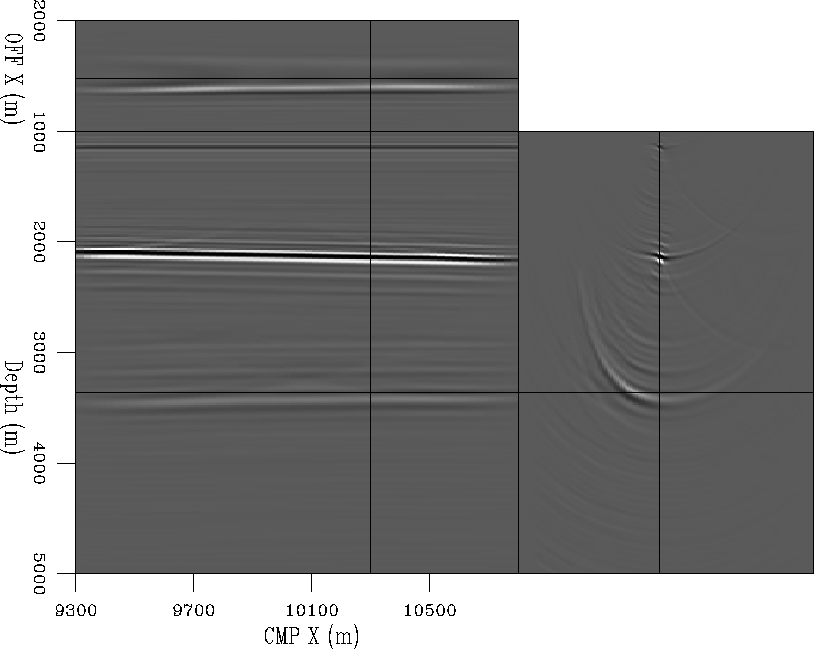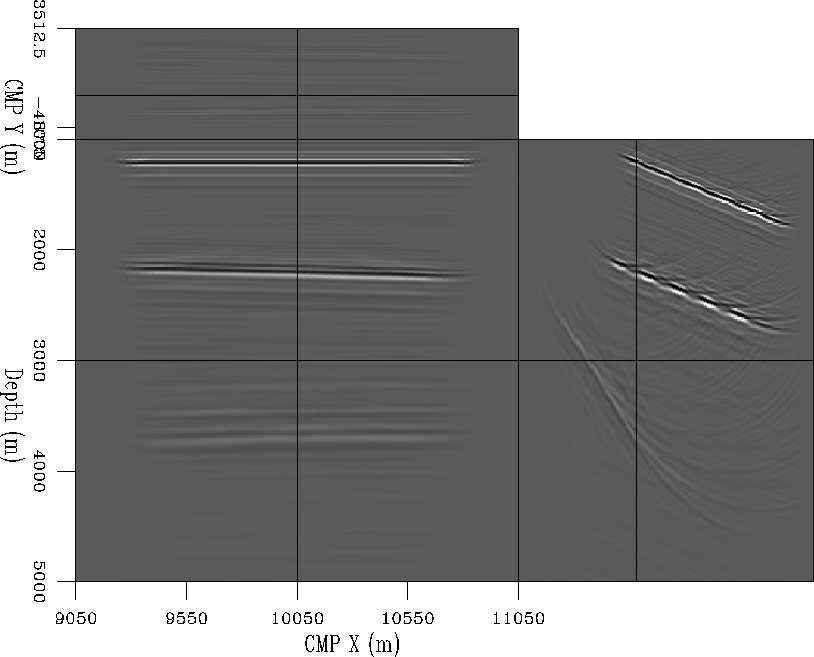




Next: Source-Receiver Migration
Up: Preprocessing
Previous: Datuming
In order to choose the key migration parameters such as depth step, number
of frequencies and especially padding of negative subsurface offsets to
accommodate the migration of the multiples, we run some tests using
common-azimuth migration.
Rather than mapping the non-zero crossline offsets to zero cross-line offset
via Azimuth Moveout, AMO, for compuitational simplicity we just windowed the
nearest crossline offsets and assigned them to zero crossline offset.
Figure ![[*]](http://sepwww.stanford.edu/latex2html/cross_ref_motif.gif) shows
the inline dimensions (CMP and offset) of an SODCIG after common-azimuth
migration. Notice that the multiples have been mapped to the negative
subsurface offsets and to shallower depths, consistent with the results
obtained by Alvarez 2005. Figure
shows
the inline dimensions (CMP and offset) of an SODCIG after common-azimuth
migration. Notice that the multiples have been mapped to the negative
subsurface offsets and to shallower depths, consistent with the results
obtained by Alvarez 2005. Figure ![[*]](http://sepwww.stanford.edu/latex2html/cross_ref_motif.gif) shows the zero subsurface offset cube which shows that the migrated image is good
in the inline direction where the sampling was good but is poor in the
crossline direction where the CMP sampling was coarse. Notice the
multiple that was migrated with roughly twice the crossline dip and in the
updip direction.
shows the zero subsurface offset cube which shows that the migrated image is good
in the inline direction where the sampling was good but is poor in the
crossline direction where the CMP sampling was coarse. Notice the
multiple that was migrated with roughly twice the crossline dip and in the
updip direction.
cam1
Figure 10 Inline SODCIG obtained by common-azimuth
migration.




 cam2
cam2
Figure 11 Zero subsurface-offset cube of data migrated with
common azimuth migration.










Next: Source-Receiver Migration
Up: Preprocessing
Previous: Datuming
Stanford Exploration Project
4/6/2006
![[*]](http://sepwww.stanford.edu/latex2html/cross_ref_motif.gif) shows
the inline dimensions (CMP and offset) of an SODCIG after common-azimuth
migration. Notice that the multiples have been mapped to the negative
subsurface offsets and to shallower depths, consistent with the results
obtained by Alvarez 2005. Figure
shows
the inline dimensions (CMP and offset) of an SODCIG after common-azimuth
migration. Notice that the multiples have been mapped to the negative
subsurface offsets and to shallower depths, consistent with the results
obtained by Alvarez 2005. Figure ![[*]](http://sepwww.stanford.edu/latex2html/cross_ref_motif.gif) shows the zero subsurface offset cube which shows that the migrated image is good
in the inline direction where the sampling was good but is poor in the
crossline direction where the CMP sampling was coarse. Notice the
multiple that was migrated with roughly twice the crossline dip and in the
updip direction.
shows the zero subsurface offset cube which shows that the migrated image is good
in the inline direction where the sampling was good but is poor in the
crossline direction where the CMP sampling was coarse. Notice the
multiple that was migrated with roughly twice the crossline dip and in the
updip direction.

